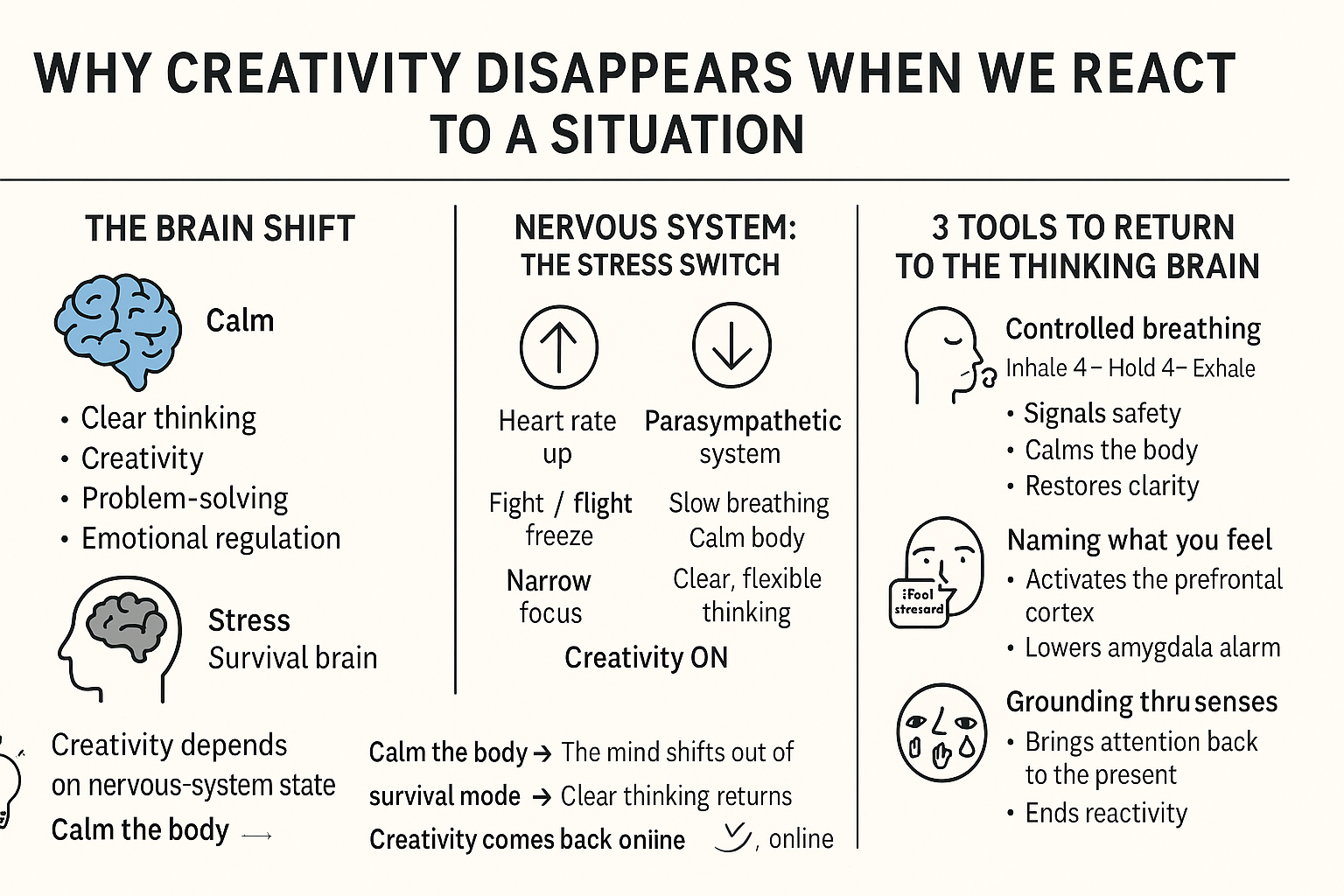Why our thinking changes when we react

Most people think creativity works like a light switch: you either have ideas or you don’t. In reality, it has far more to do with what part of your brain is in charge.
When everything feels calm and safe, your prefrontal cortex does the work. That’s the part of your brain that helps you think clearly, plan, solve problems, and come up with new ideas. But the moment something feels threatening or stressful, your brain switches control. It hands the steering wheel to the older survival system sometimes called the reptile brain. Creativity drops instantly.
This shift is automatic. It happens to everyone. It’s built into how humans survive danger. But it also explains why good ideas disappear in arguments, why we become reactive under pressure, and why thinking clearly becomes almost impossible during stress.
Understanding this reaction helps you understand yourself and others. And once you see what’s happening in the brain, you can learn to switch back into the thinking mode on purpose instead of staying stuck in survival mode.
What happens in the brain during stress
Your brain works with two systems:
The prefrontal cortex
This is the smart, modern part of your brain. It helps with planning, creativity, language, empathy, self-control, and decision-making. When this part is active, you think clearly and act intentionally.The survival system (reptile brain)
This part includes the amygdala and brainstem. Its only job is to keep you alive. It reacts fast, without thinking. When it takes over, your brain shifts into fight, flight, or freeze.
The problem is that your brain can’t run both systems at the same time. When the reptile brain activates, the prefrontal cortex goes offline. That’s why you can’t come up with ideas, think straight, or communicate well when you’re overwhelmed or triggered.
You aren’t “losing your mind.”
You’re losing access to the part that thinks.
Sympathetic and parasympathetic systems
To understand what’s happening in the body, you need to know two parts of the nervous system:
The sympathetic system
This is the “fight or flight” system. Your heart speeds up, your muscles tighten, and your focus narrows. The body prepares for danger. Creativity shuts down.
The parasympathetic system
This is the “rest and digest” system. It slows the body down, stabilizes your breathing, lowers your heart rate, and restores calm. When it turns back on, your prefrontal cortex comes back online, and your thinking becomes flexible again.
Your goal is not to avoid stress. Your goal is to return to the parasympathetic system as fast as possible so your mind can work again.
Why creativity disappears so quickly
Creativity requires a few basic conditions:
You need mental space.
You need a sense of safety.
You need access to flexible thinking.
You need emotional stability.
The survival brain blocks all of these. It forces your mind into a narrow, reactive mode because, from an evolutionary perspective, pausing to be creative during danger would get you killed. This made sense when threats were predators or physical danger.
Todays “danger” might be:
a difficult conversation
a harsh comment
social pressure
unexpected change
fear of failure
sensory overload
Yet your brain responds as if a predator is running toward you. The creativity switch goes off.
How to come back to your prefrontal cortex

You can’t think your way back into calm. You have to work with your body first. Here are three simple tools that pull you out of reptile mode and return control to the prefrontal cortex.
Tool 1: breathing to reset your system
When you slow your breathing, you send a direct message to your nervous system that you are not in danger. A simple pattern works well:
Inhale through the nose for 4 seconds
Hold for 4 seconds
Exhale through the mouth for 6 seconds
The longer exhale activates the parasympathetic system. Within one to two minutes you’ll feel your thinking begin to clear.
Tool 2: naming the emotion
When you say “I feel nervous,” “I feel overwhelmed” or “I feel angry,” the prefrontal cortex automatically activates. This is called affect labeling. Naming the emotion calms the amygdala and brings thinking back online.
You don’t need a long explanation. Just naming what you feel is enough to interrupt the stress cycle.
Tool 3: grounding your senses
When your mind is in survival mode, your attention leaves the present moment. Grounding brings you back into your body and out of the threat response. Try this:
Notice:
5 things you can see
4 things you can touch
3 things you can hear
2 things you can smell
1 thing you can taste
This pattern slows the stress response and reconnects your mind with your physical environment. When your body feels safe, your brain stops reacting.
Understanding others with more compassion
Knowing how the brain reacts under stress makes it easier to understand why people behave the way they do. When someone becomes defensive, shuts down, or snaps, it doesn’t necessarily mean they’re being difficult. It may mean they’re overwhelmed and have lost access to the part of the brain that helps them behave well.
This awareness makes you more patient, more supportive, and less likely to take things personally. It helps you guide conversations toward calm instead of escalation.
The takeaway
Creativity disappears when your brain senses danger because the survival system takes over. This is normal. But you’re not powerless. With a few simple tools, you can turn off the reactive mode and return to the thinking mode where your creativity, clarity, and problem-solving live.
A calm brain is a creative brain.
The more you understand this process, the more control you gain over yourself, your reactions, and your life.

